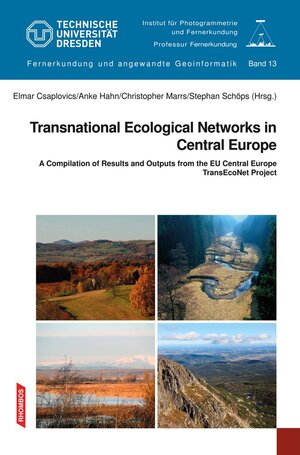Transnational Ecological Networks in Central Europe
Volume 13 of the series "Remote Sensing and Applied Geoinformatics"
von Elmar Csaplovics, Anke Hahn, Christopher Marrs und Stephan SchöpsElmar Csaplovics/Anke Hahn/Christopher Marrs/Stephan Schöps (Editors)
Transnational Ecological Networks in Central Europe
A Compilation of Results and Outputs from the EU Central Europe TransEcoNet Project
Volume 13 of the series „Remote Sensing and Applied Geoinformatics“ Published by Univ. Prof. Dr. habil. Elmar Csaplovics, Lehrstuhl Remote Sensing, FR Geowissenschaften, TU Dresden
264 pages, format DIN B5 (176 x 250 mm), weight 0.55 kg, cover: paperback, numerous illustrations, many of them colored. Language: English. Price: 39,80 Euro. ISBN 9783941216860. Publishing house: Rhombos Verlag, Berlin 2018
About this book
In Central Europe protected areas, such as national parks or biosphere reserves, are often isolated patches of nature conservation. They are surrounded by less protected and/or unprotected areas. Frequently these surrounding areas are intensively used for agriculture, transport infrastructure, industrial sites and human settlements. For animal and plant species the intensive use of landscapes can create barriers which can reduce genetic exchange, posing a threat to biodiversity. To provide animals and plants with possibilities for migration, dispersal and forage and to conserve biodiversity in the long run, valuable natural landscapes need to be spatially connected by ecological networks. Central Europe’s rural border regions are particularly characterised by an interesting mosaic of protected and non-protected areas, though the non-protected areas can still be ecologically valuable nonetheless. Nowadays with the political and economic integration of Europe these former remote landscapes are affected by rapid changes and borderlands are facing the challenge of finding a balance between economic development on the one hand, and protection of their valuable natural and cultural heritage on the other. The idea of the project TransEcoNet (Transnational Ecological Networks in Central Europe) has been to analyse border areas in Central Europe regarding the spatial coherence of ecological networks, the status of biodiversity and ecosystem services and land use development past and present. In addition to spatio-ecological analyses socio-cultural topics such as awareness of ecological networks and general regional ecological values have also been considered. In this publication the scope of project work and the most relevant results are presented. The individual chapters cover an inventory of ecological networks in Central Europe, an analysis of the history of these ecological networks, the assessment of their biodiversity and ecosystem services in selected regions as well as strategies for raising awareness for ecology as such and for ecological networks in particular. The articles within the chapters have varying spatial foci and also cover regional and local elements. The results of the project presented in this publication are trans-disciplinary and connect the work of experts coming from remote sensing, nature conservation and environmental education, landscape ecology and conservation biology, regional and spatial planning, as well as cultural history and architecture.
The TransEcoNet project was implemented by the CENTRAL EUROPE Programme cofinanced by the European Regional Development Fund.
Volume 13 of the series „Remote Sensing and Applied Geoinformatics“ Published by Univ. Prof. Dr. habil. Elmar Csaplovics, Lehrstuhl Remote Sensing, FR Geowissenschaften, TU Dresden
264 pages, format DIN B5 (176 x 250 mm), weight 0.55 kg, cover: paperback, numerous illustrations, many of them colored. Language: English. Price: 39,80 Euro. ISBN 9783941216860. Publishing house: Rhombos Verlag, Berlin 2018
About this book
In Central Europe protected areas, such as national parks or biosphere reserves, are often isolated patches of nature conservation. They are surrounded by less protected and/or unprotected areas. Frequently these surrounding areas are intensively used for agriculture, transport infrastructure, industrial sites and human settlements. For animal and plant species the intensive use of landscapes can create barriers which can reduce genetic exchange, posing a threat to biodiversity. To provide animals and plants with possibilities for migration, dispersal and forage and to conserve biodiversity in the long run, valuable natural landscapes need to be spatially connected by ecological networks. Central Europe’s rural border regions are particularly characterised by an interesting mosaic of protected and non-protected areas, though the non-protected areas can still be ecologically valuable nonetheless. Nowadays with the political and economic integration of Europe these former remote landscapes are affected by rapid changes and borderlands are facing the challenge of finding a balance between economic development on the one hand, and protection of their valuable natural and cultural heritage on the other. The idea of the project TransEcoNet (Transnational Ecological Networks in Central Europe) has been to analyse border areas in Central Europe regarding the spatial coherence of ecological networks, the status of biodiversity and ecosystem services and land use development past and present. In addition to spatio-ecological analyses socio-cultural topics such as awareness of ecological networks and general regional ecological values have also been considered. In this publication the scope of project work and the most relevant results are presented. The individual chapters cover an inventory of ecological networks in Central Europe, an analysis of the history of these ecological networks, the assessment of their biodiversity and ecosystem services in selected regions as well as strategies for raising awareness for ecology as such and for ecological networks in particular. The articles within the chapters have varying spatial foci and also cover regional and local elements. The results of the project presented in this publication are trans-disciplinary and connect the work of experts coming from remote sensing, nature conservation and environmental education, landscape ecology and conservation biology, regional and spatial planning, as well as cultural history and architecture.
The TransEcoNet project was implemented by the CENTRAL EUROPE Programme cofinanced by the European Regional Development Fund.








